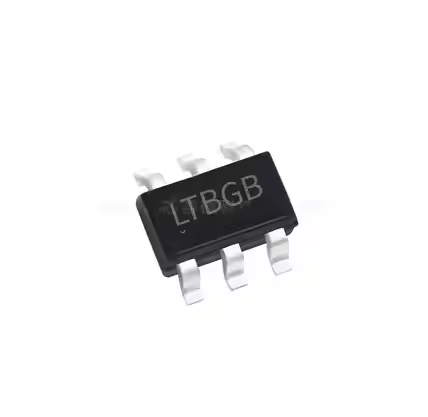Analog Devices Inc LT3462ES6#TRMPBF +BOM
The LT3462ES6#TRMPBF by Analog Devices Inc is a fixed - frequency inverting DC/DC converter. It integrates a Schottky rectifier and has a low VCESAT switch. With a 1.2MHz switching frequency, it can generate negative output voltages like -5V at 100mA from 5V input. It's used in applications such as CCD, LCD, and GaAs FET bias. Housed in a 6 - lead TSOT - 23 package, it's suitable for space - constrained designs.
Analog Devices Inc LT3462ES6#TRMPBF's Features
I. Core Architecture and Performance
Integrated Schottky Diode: Built-in Schottky rectifier simplifies circuit design and reduces component cost and board space.
Fixed Frequency Operation
LT3462: 1.2MHz switching frequency (ES6 package corresponds to this version).
High-frequency operation enables the use of small, low-cost inductors and capacitors (e.g., ceramic capacitors), suitable for space-constrained applications.
Low Noise Characteristics:Output ripple as low as 1 mV<sub>P-P</sub> (with ceramic capacitors), superior to the low-frequency noise issues of charge pump solutions.
Low Saturation Voltage Switch:Switch collector-emitter saturation voltage (V<sub>CESAT</sub>) is only 270mV@250mA, improving conversion efficiency.
II. Input and Output Characteristics
Input voltage (V<sub>IN</sub>): 2.5V~16V, adaptable to various power supply scenarios.
High Output Voltage Capability: Output voltage (V<sub>OUT</sub>) can reach as low as -38V (with a maximum differential of 38V between V<sub>IN</sub> and V<sub>OUT</sub> in a dual-inductor topology).
Typical Output Configurations: 5V input → -5V output (100mA); 3.3V input → -12V output (30mA).
Reference Voltage and Feedback
Built-in 1.265V low-impedance voltage reference (SDREF pin) powers the feedback resistor network.
Ground-referenced high-impedance FB pin supports high-value feedback resistors without compromising output accuracy.
III. Efficiency and Power Consumption
Typical efficiency curves: ~75% efficiency at 100mA load with 5V input; ~70% efficiency at 30mA load for 3.3V input to -12V output (see typical performance graphs in the document).
Low Quiescent Current
Shutdown mode current: <10µA (when the SDREF pin is pulled low).
Low input bias current during operation, suitable for battery-powered devices.
IV. Packaging and Dimensions
TSOT-23 Package (S6)
6-pin thin package with a thickness of only 1mm and compact dimensions (3.85mm×2.90mm), suitable for surface mounting.
Exposed pad (GND) must be soldered to the PCB ground layer for optimized thermal performance (θ<sub>JA</sub>=192°C/W).
Lead-Free Process
Compliant with environmental requirements, marked as “#PBF”.
V. Protection and Reliability
Current Limiting and Thermal Protection
Switch current limit: 300~420mA (400mA typical), preventing damage from overloading.
Maximum junction temperature: 125°C, operating temperature range: -40°C~85°C, suitable for industrial-grade applications.
Inrush Current Control
Built-in Schottky diode can withstand a maximum non-repetitive inrush current of 1.5A. By selecting appropriate inductors and capacitors (e.g., L=22µH, C=1µF), the inrush peak can be limited to below 0.7A.
VII. Key Parameter Comparison (LT3462 vs LT3462A)
| Characteristic | LT3462 (ES6 Package) | LT3462A (e.g., EDC Package) |
|---|---|---|
| Switching Frequency | 1.2MHz | 2.7MHz |
| Maximum Duty Cycle | 90% | 77% |
| Package Type | TSOT-23 (6-pin) | DFN (8-pin, 2mm×2mm) |
| Typical Application Inductance | 22µH (dual inductors) | 10µH (coupled inductor) |
Analog Devices Inc LT3462ES6#TRMPBF's Applications
I. Negative Voltage Biasing Systems
Advantages:
Low output ripple (1 mV<sub>P-P</sub>) avoids noise interference with image signals, ensuring high-resolution imaging.
Wide input range (2.5V–16V) adapts to various power sources (e.g., batteries or system supplies), supporting portable imaging devices (e.g., industrial cameras, medical endoscopes).
Advantages:
High-frequency switching (1.2MHz) enables the use of small inductors and capacitors, saving PCB space for thin and light displays (e.g., LCD backlight drivers for mobile phones and tablets).
High output voltage capability (down to -38V) meets the biasing voltage requirements of high-resolution LCDs (e.g., -5V to -20V ranges).
Advantages:
Low noise characteristics reduce RF signal distortion, enhancing signal quality in communication devices (e.g., base station RF modules, satellite receivers).
High efficiency (typical 70%–75%) reduces power consumption, suitable for RF front-end designs with strict heat dissipation requirements.
II. General-Purpose Negative Voltage Power Supplies
Typical Configurations:
5V input to -5V/100mA for symmetrical power supplies for operational amplifiers.
12V input to -36V/36mA for high-voltage analog circuits or sensor biasing (e.g., photomultiplier tubes).
Reliability Advantages:
Wide temperature range (-40°C–85°C) suits industrial environments, with built-in current limiting (400mA) and thermal protection against overloads.
Low-Power Advantages:
Shutdown mode current <10µA extends battery life, ideal for wireless sensors (e.g., environmental monitoring devices, wearable sensors).
Compact package (TSOT-23, 1mm thickness) fits miniaturized PCB layouts, meeting space constraints in IoT modules.
III. Battery-Powered Devices
Typical Circuits:
3.3V input to -12V/30mA for high-voltage circuits in medical devices (e.g., boost pumps, sensors).
Lithium battery (2.7V–4.2V) input to -8V for low-power RF chips or signal conditioning circuits.
Efficiency and Layout:
High-frequency switching (1.2MHz) allows small inductors (e.g., 22µH) and ceramic capacitors, reducing external component size.
Low saturation voltage switch (270mV) improves battery energy utilization and extends runtime.
IV. Special Application Scenarios
Advantages:
Fixed-frequency current mode control eliminates random switching noise in charge pumps, with output ripple as low as 1 mV<sub>P-P</sub>.
Dual-inductor topology filters both input and output currents, suitable for applications requiring high power purity (e.g., laboratory instruments, avionics).
Configuration Example:
5V main power input generates +3.3V (via other converters) and -5V (via LT3462) simultaneously, providing symmetrical power for ADCs/DACs.
Space-saving: Integrated Schottky diode reduces external components compared to discrete solutions.
V. Application Design Considerations
Inductors: Dual-inductor topology recommends 22µH (e.g., Sumida CLS62-220), saturation current ≥0.25A, DC resistance (DCR) <1Ω.
Capacitors: X7R/X5R ceramic capacitors for input/output (1µF–10µF), flying capacitor (between SW-D pins) ≥1µF, voltage rating higher than input/output voltage differential.
Input capacitor (1µF ceramic) must be close to the VIN pin to reduce high-frequency noise.
Ground pins (GND) and exposed pads should connect directly to the PCB ground layer to minimize ground impedance and thermal resistance (θ<sub>JA</sub>=192°C/W).
Ensure it does not exceed 1.5A (e.g., L=22µH, C=1µF yields I<sub>P</sub>=0.7A).
VI. Application Comparison (LT3462 vs Other Devices)
| Application Scenario | LT3462 Advantages | Alternative Devices | Key Differences |
|---|---|---|---|
| Low-Noise Negative Voltage Supply | 1 mV<sub>P-P</sub> ripple, fixed frequency | LT1617 | Higher efficiency (75% vs. LT1617’s 70%), integrated Schottky |
| High-Frequency Miniaturized Design | 1.2MHz switching frequency, TSOT-23 1mm package | LT3462A | Lower frequency (suitable for EMI-sensitive scenarios) |
| Battery-Powered Low-Power Systems | Shutdown current <10µA, low bias current | LT1931 | Lower quiescent current (ideal for long battery life) |
Analog Devices Inc LT3462ES6#TRMPBF's Attributes
| Product Category | Switching Voltage Regulators | RoHS | Details |
| Output Voltage | - 38 V | Output Current | 300 mA |
| Input Voltage, Max | 16 V | Number of Outputs | 1 Output |
| Topology | Inverting | Package / Case | SOT-23-6 |
| Mounting Style | SMD/SMT | Switching Frequency | 1.2 MHz |
| Quiescent Current | 10 uA | Minimum Operating Temperature | - 40 C |
| Maximum Operating Temperature | + 85 C | Series | LT3462 |
| Input Voltage, Min | 2.5 V | Brand | Analog Devices |
| Development Kit | DC670A | Height | 1 mm |
| Input Voltage | 2.5 V to 16 V | Operating Supply Current | 2.9 mA |
| Product Type | Switching Voltage Regulators | Shutdown | Shutdown |
| Factory Pack Quantity | 500 | Subcategory | PMIC - Power Management ICs |
| Supply Voltage - Min | 2.5 V | Type | DC/DC Converters with Integrated Schottky |
| Unit Weight | 0.005488 oz |
Analog Devices Inc LT3462ES6#TRMPBF's Datasheet
Analog Devices Inc LT3462ES6#TRMPBF's Category-DC to DC Converter
DC/DC switching regulators are integrated circuits (ICs) that play a crucial role in modern electronics. These regulators are designed to efficiently convert one DC voltage level to another, either stepping up (boost), stepping down (buck), or inverting the voltage. One of the key advantages of DC/DC switching regulators is their high efficiency. Unlike linear regulators that dissipate power as heat, switching regulators store energy in inductors or capacitors and transfer it to the output. This results in significantly less power loss, making them ideal for battery - powered devices where energy conservation is essential. They also offer a wide input voltage range, which allows them to operate with various power sources. Additionally, switching regulators can provide multiple output voltages, which is beneficial for complex electronic systems that require different voltage levels for different components. DC/DC switching regulators come in different topologies, such as buck, boost, buck - boost, and flyback. Each topology is suitable for specific applications depending on the input and output voltage requirements, load current, and efficiency needs.
The Analog Devices Inc LT3462ES6#TRMPBF is an example of a high - performance DC/DC switching regulator IC. It is an inverting regulator that can generate negative output voltages. With its integrated Schottky rectifier, fixed - frequency operation, and low - voltage drop switch, it offers high efficiency. It has a wide input voltage range and can supply negative voltages for applications like CCD bias, LCD bias, and GaAs FET bias. Its compact 6 - lead TSOT - 23 package makes it suitable for space - constrained designs, further highlighting the versatility and importance of DC/DC switching regulator ICs in today's electronics.
LT3462ES6#TRMPBF's Manufacturer-Analog Devices Inc
LT3462ES6#TRMPBF vs LT3462AES6#PBF
| Item | LT3462ES6#TRMPBF +BOM | LT3462AES6#PBF +BOM |
|---|---|---|
| Manufacturer | Analog Devices Inc. | Analog Devices Inc. |
| Package | SOT-23-6 | SOT-23-6 |
| Description | Cuk Switching Regulator IC, Negative Adjustable, -1.265V, 1 Output, 250mA, SOT-23-6 Thin, TSOT-23-6 | LT3462AES6#PBF is a DC-DC converter with an input voltage range of 2.5V to 16V and an output voltage of -38V at 0.42A |
| Stock | 3178 | 5344 |
| RoHS Compliance | Yes | Yes |
| Output Voltage | -38V | -38V |
| Maximum Output Current | 300mA | 300mA |
| Collector-Emitter Maximum Voltage (VCEO) | 16V | 16V |
| Number of Outputs | 1 Output | 1 Output |
71421LA55J8 UPD44165184BF5-E40-EQ3-A SST39VF800A-70-4C-B3KE IS66WV1M16DBLL-55BLI-TR AS4C32M16SB-7BIN W25Q16FWSNIG
AS7C34098A-20JIN 752369-581-C W957D6HBCX7I TR IS61LPS12836EC-200B3LI MX25L12875FMI-10G QG82915PL
Product information is from SIC Electronics Limited. If you are interested in the product or need product parameters, you can contact us online at any time or send us an email: sales@sic-chip.com.











 Wishlist (0 Items)
Wishlist (0 Items) 